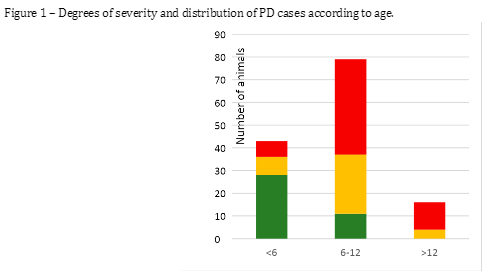Clinical laboratory profiling and microbiological analysis of the oral cavity of dogs (Canis familiaris) with dental disorders
DOI:
https://doi.org/10.21708/avb.2024.18.2.12306Resumo
Periodontal disease (PD) is caused by the accumulation of biofilm in the oral cavity. Biofilm is a viscous, yellowish film that is initially composed of non-pathogenic bacteria; the biofilm creates an environment that is conducive to the proliferation of pathogenic Gram-negative bacteria if it is not removed, leading to periodontitis. This study identified the bacteria present in oral cavity samples from 22 dogs with dental disorders and related them to clinical and laboratory findings. To identify these microorganisms, samples were collected and cultivated in a variety of culture media and bacterial identification was carried out using biochemical tests. We also performed antimicrobial susceptibility tests to select the most appropriate treatment for each case. The results showed that the dogs in the study presented with anemia, leukocytosis, and increased plasma protein, which were possibly associated with PD. The most severe periodontal changes were observed in dogs between 6 and 12 years old that consumed moist and/or soft foods. We identified eight species of bacteria, including Klebsiella aerogenes, Pantoea agglomerans, Escherichia coli, Klebsiella oxytoca, Klebsiella pneumoniae, Proteus mirabilis, Proteus vulgaris, Pseudomonas aeruginosa, and bacteria from the genus Clostridium sp. These results highlight the importance of the antibiogram and of restricting the use of broad-spectrum antibiotics as complementary treatment for PD.
Downloads

Downloads
Publicado
Edição
Seção
Licença
Copyright (c) 2024 Acta Veterinaria Brasilica

Este trabalho está licenciado sob uma licença Creative Commons Attribution 4.0 International License.
Autores que publicam na Acta Veterinaria Brasilica concordam com os seguintes termos: a) Autores mantém os direitos autorais e concedem à revista o direito de primeira publicação, com o trabalho simultaneamente licenciado sob a Licença Creative Commons Attribution que permite o compartilhamento do trabalho com reconhecimento da autoria e publicação inicial nesta revista. b) Autores têm autorização para assumir contratos adicionais separadamente, para distribuição não-exclusiva da versão do trabalho publicada nesta revista (ex.: publicar em repositório institucional ou como capítulo de livro), com reconhecimento de autoria e publicação inicial nesta revista. c) Autores têm permissão e são estimulados a publicar e distribuir seu trabalho online (ex.: em repositórios institucionais ou na sua página pessoal) a qualquer ponto antes ou durante o processo editorial, já que isso pode gerar alterações produtivas, bem como aumentar o impacto e a citação do trabalho publicado (Veja O Efeito do Acesso Livre).


 Esta obra está licenciada com uma Licença
Esta obra está licenciada com uma Licença 